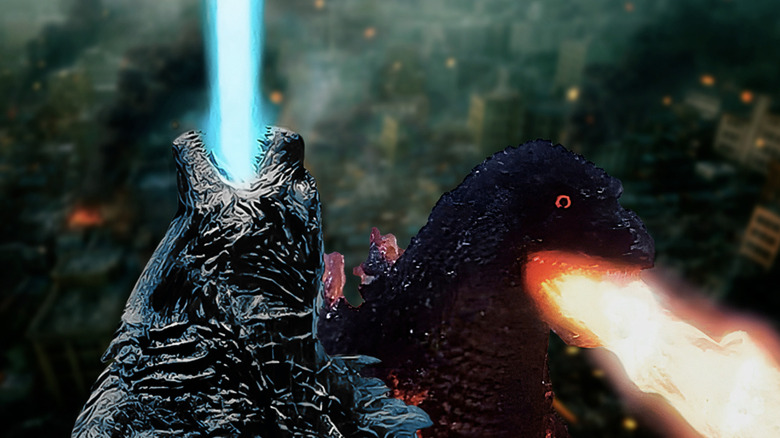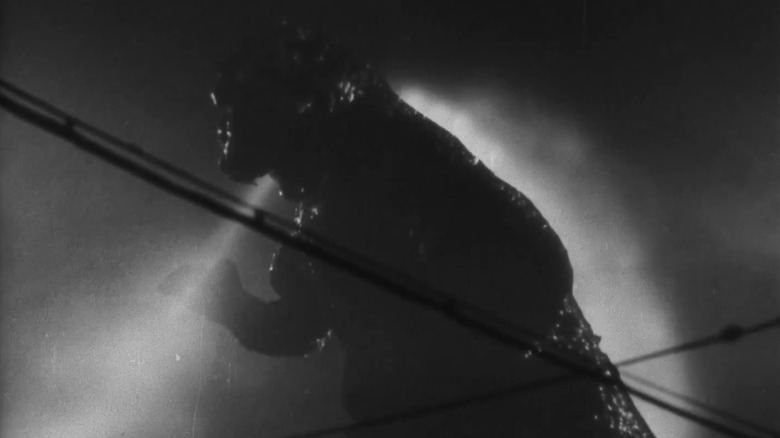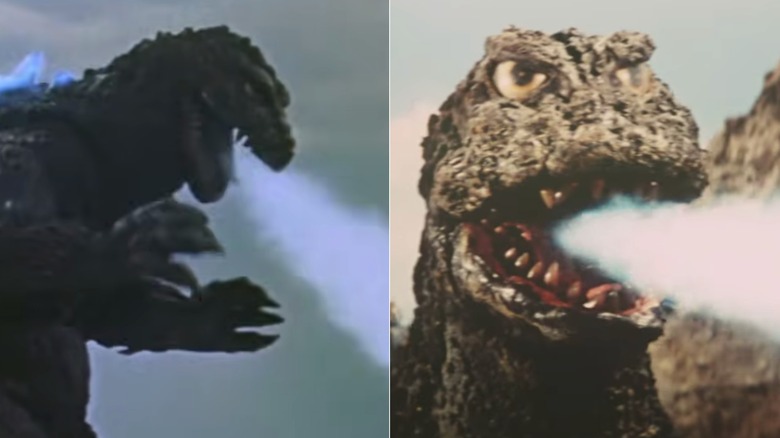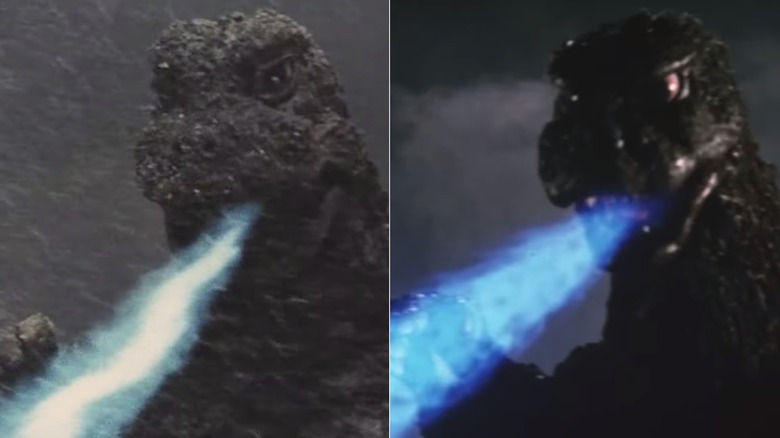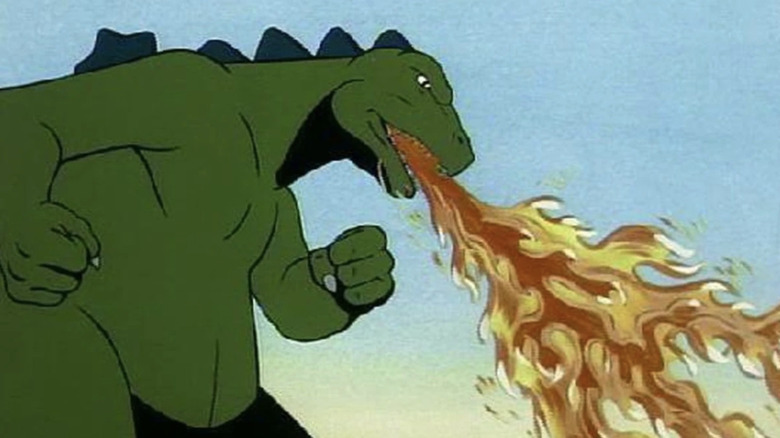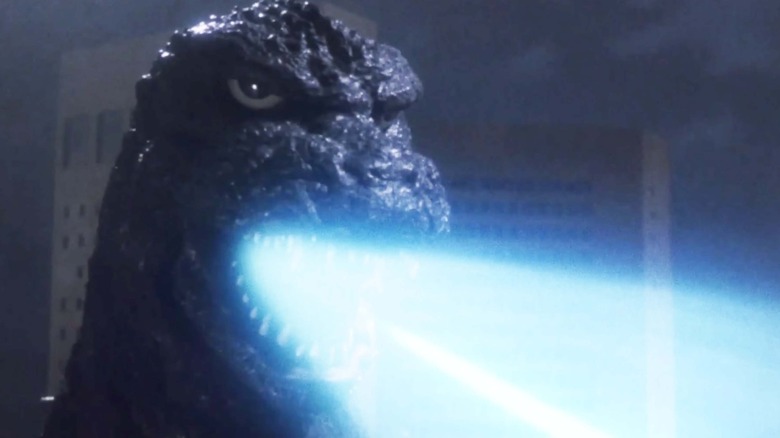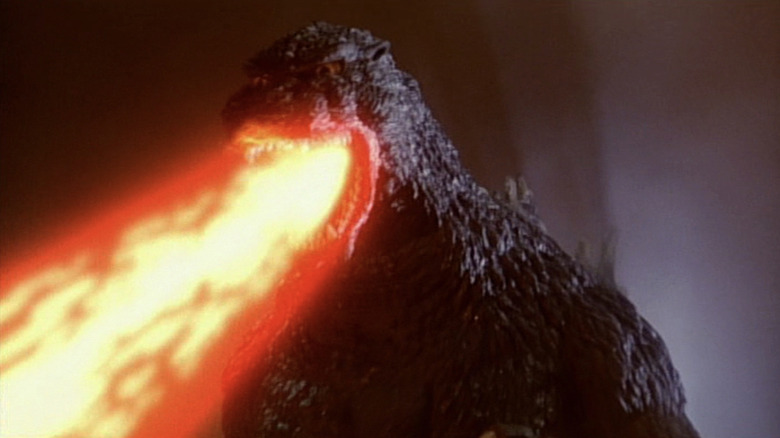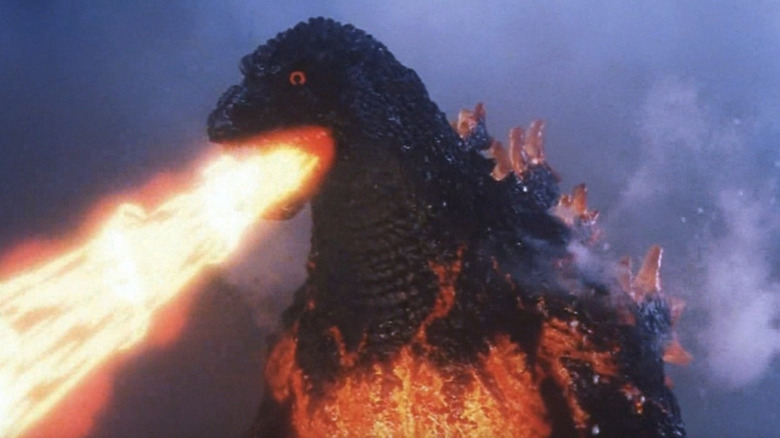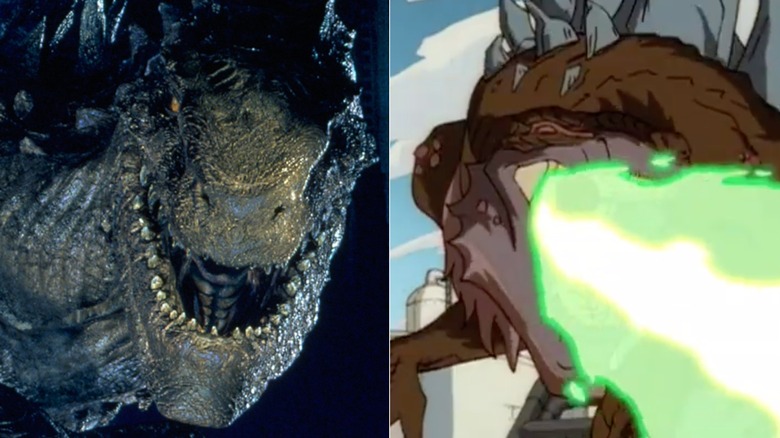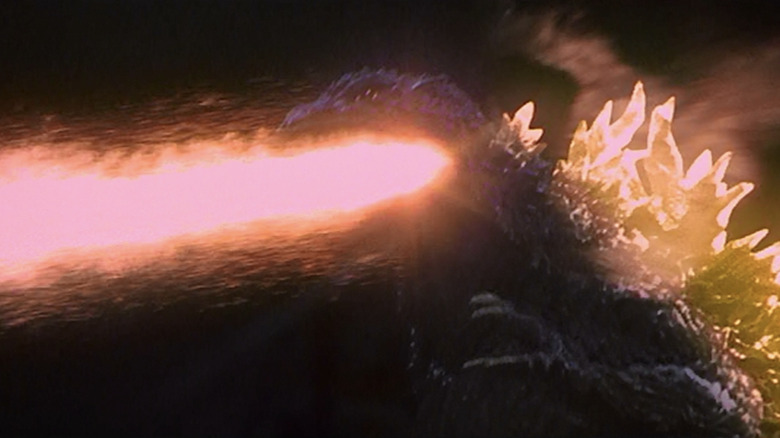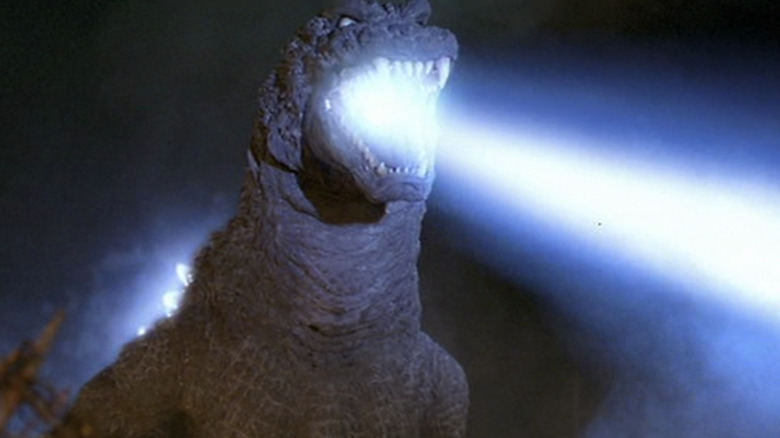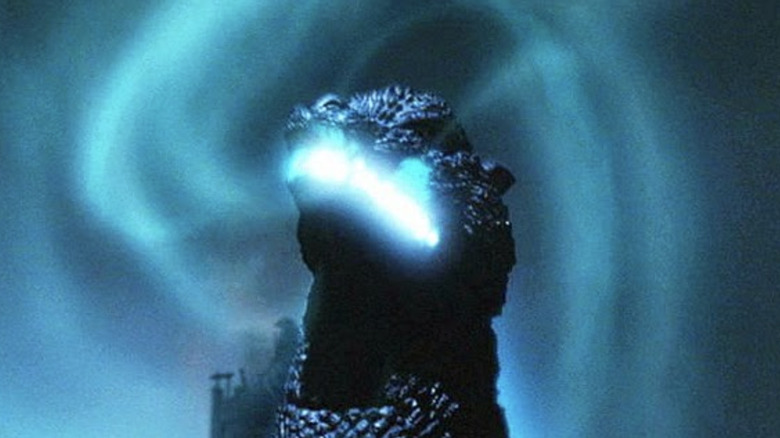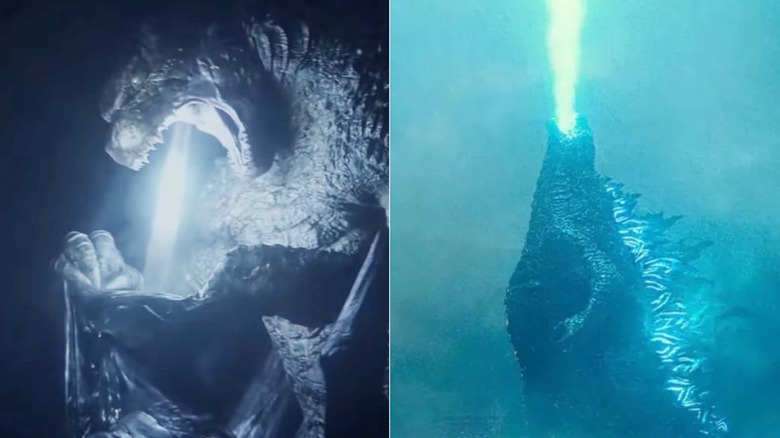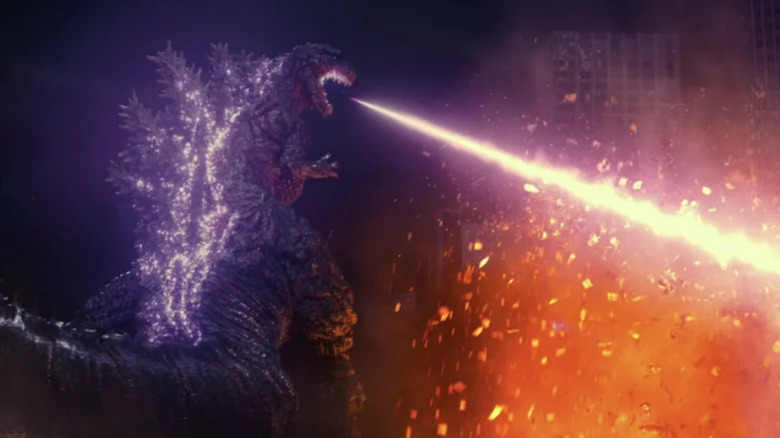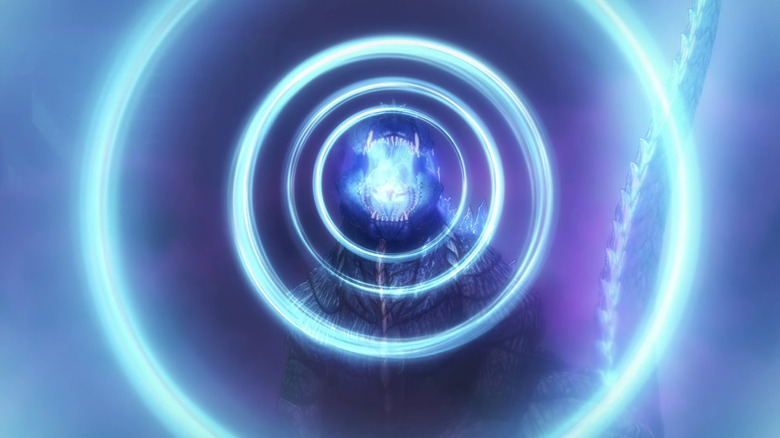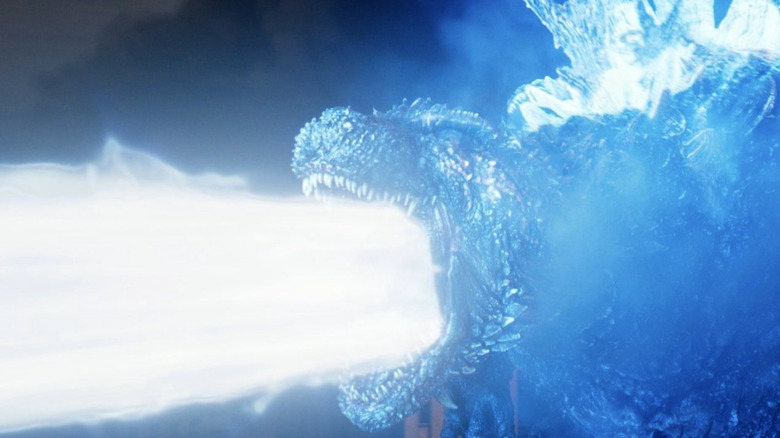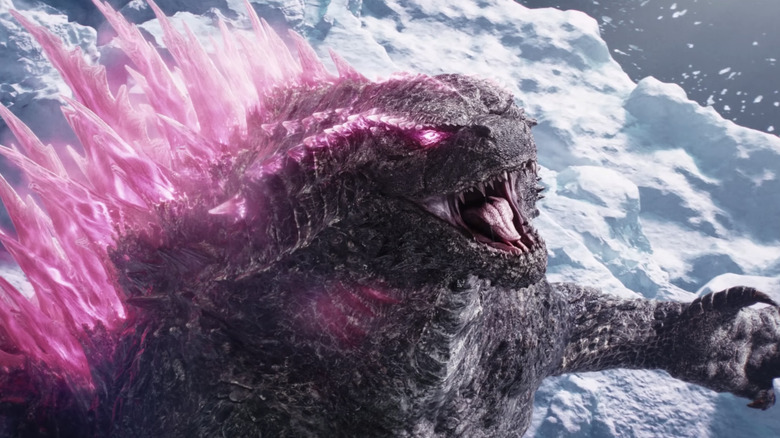The Evolution Of Godzilla's Atomic Breath Explained
Ever since the monster's debut in 1954, Godzilla has towered over his kaiju competition. But from the original "Gojira" to the present, the King of the Monsters has displayed one colorful trademark that sets him apart from his contemporaries. That's right, we're talking about Godzilla's atomic breath, an ability that invokes the fire-breathing dragons of old but with infinitely more power. So how does Godzilla's atomic breath work? Well, the exact "how" changes depending on the story, but it generally looks something like this.
As the giant monster's dorsal fins begin to glow, Godzilla charges up an atomic heat ray of ionized radiation that bellows from his jaws at will, generally in a concentrated blast of varying power levels depending on color, intensity, and plot. The King of the Monster's spiky fins can absorb different forms of energy, from nuclear power to one's life force, which can double or even sometimes triple his power. With so many versions of Godzilla out there, we're here to help sort out the evolution of the King of the Monster's trademark superpower.
Godzilla's atomic breath was originally more of a mist
When we first met Godzilla in the 1954 Japanese picture "Gojira," our favorite giant monster's atomic breath had yet to be fully realized. But make no mistake, Godzilla still carried his signature heat ray, though it looked more like a thin mist with a smoky feel rather than the traditional blue beam we know today. Because the first two films were in black-and-white, Godzilla's original atomic breath generally looked white or translucent, not unlike the atomic bomb itself, which Toho intended to comment on with their giant monster.
The King of the Monster's atomic breath mimicked the bomb's destruction, and, despite its smoggy texture, it was hot enough to melt and warp power cables and set Tokyo ablaze. It might not be as well defined as future versions of his atomic breath, but the original Godzilla's heat ray was just as formidable. No atomic bomb would stop Godzilla, and that's part of what made him so frightening to begin with. This continued to be the look of Godzilla's signature move throughout the first batch of films of the Shōwa Era, including the sequel "Godzilla Raids Again." However, the usual blue look wasn't far behind.
The atomic breath's blue hue was added later
In Godzilla's third feature film, "King Kong vs. Godzilla" (not to be confused with 2021's "Godzilla vs. Kong"), a slight blueish hue was added to the King of the Monster's translucent heat ray. Given that this was the first "Godzilla" film released in color, one could assume that our gigantic hero always had a blueish tint to his trademark atomic breath. In fact, that's how Toho always saw it. From here on out, the signature radioactive blue became the trademark look for Godzilla.
But why blue? Well, "King Kong vs. Godzilla" reveals that it's because of the Cherenkov radiation that's generated in nuclear reactors, especially those that, like Godzilla, exist underwater. It's worth noting that despite the misty appearance, Godzilla's back plates still glow an atomic light blue before firing his heat ray, which also nods to the Cherenkov effect. However, the whiter misty appearance returned (albeit with the blueish accent) in subsequent Shōwa Era films such as "Mothra vs. Godzilla," "Ghidorah, the Three-Headed Monster," "Invasion of Astro-Monster," and "Ebirah, Horror of the Deep."
Godzilla's atomic breath became more defined
It wasn't until 1967's "Son of Godzilla" that the atomic breath mutated from a concentrated radioactive smog into the laser-like heat ray we know today. In this eighth installment, Godzilla adopts the kaiju Minilla (yes, Godzilla has a son) and teaches him how to use his atomic breath. Though Minilla only gets a few puffs out at first, which appear as rings of nuclear energy, he eventually takes his adoptive father's lessons to heart and blasts a blue heat ray of his own. Though the beam still has a foggy note to it, the concentrated effect, now highlighted with an electric blue, pushed Godzilla into a new age.
This look remained relatively the same throughout the next four monster epics, where Godzilla bested some of the most notable kaiju in Toho's catalog. That is, until "Godzilla vs. Megalon," (yes, the one with that scene) where the series introduced an atomic blue beam that looked more fiery than misty. The next installment, "Godzilla vs. Mechagodzilla," continued this atomic blue look, though the fifteenth and final picture in the original "Godzilla" series, "Terror of Mechagodzilla," took it a step backward by emphasizing more white in the blast than blue.
Hanna-Barbara's Godzilla cartoon gave the monster fiery breath instead
A few short years after Godzilla's theatrical hiatus, cartoon giants Hanna-Barbara decided to give the King of the Monsters a go. But the animated Godzilla was unrecognizable from his live-action, rubber-suited counterpart. Our favorite monster was rebranded as a green dinosaur-like creature who breathed fire instead of his normal atomic blast. Oh, and he also had a form of heat vision akin to Superman's, which was equally strange.
To make matters worse, the animated Godzilla even had a Scrappy-Doo-inspired nephew named Godzooky, who, like the original Godzilla's adoptive son Minilla, struggled to breathe fire and instead settled for puffing out a few rings of smoke. The short-lived series ran for only two seasons and 26 episodes between 1978 and 1979, and it's no wonder why. Thankfully, this version didn't have much of a lasting impact on the "Godzilla" franchise going forward.
The Heisei Era changed the game
With the Heisei Era, Godzilla was completely rebranded. The 1984 film "The Return of Godzilla," which was released nearly a decade after "Terror of Mechagodzilla," erased all of the original sequels from its canon, with only the 1954 film considered a part of the story. Re-edited and released as "Godzilla 1985" in the United States, this Godzilla reboot used rotoscoping to create the atomic breath effect (which remained a light blue here). This beam was stronger, longer, and more powerful than ever, as "The Return of Godzilla" was meant to be a darker film that echoed the socio-political commentary of the original.
But by 1991's "Godzilla vs. King Ghidorah," the King of the Monsters upgraded our hero's atomic breath into the famed spiral heat ray that fully decapitated one of Ghidorah's heads. The spiral heat ray looks just like Godzilla's traditional blue-hued atomic breath but is coiled with an electric purple signature that gives it a bit more power. This was the first major departure from the traditional atomic breath that Godzilla frequently used throughout his decades-long film career, but it certainly wouldn't be the last.
Godzilla doubles his power with red atomic breath
Not all Godzillas are created equal, and the Godzilla of the Heisei Era proves that. After the character's return, the filmmakers continued to up the King of the Monster's game. In 1993's "Godzilla vs. Mechagodzilla II" (which is not a sequel to the original "Godzilla vs. Mechagodzilla"), our favorite monster showed off a brand new variant of his atomic heat ray: The hyper-uranium heat ray. After absorbing the life force of the dying kaiju Rodan, Godzilla was able to resume the battle against Super-Mechagodzilla, showcasing a powerful new atomic blast that emits a blast of red electrical energy.
This red heat ray made Godzilla a more formidable opponent, and he and Super-Mechagodzilla even clashed beams as a result. When Godzilla powers up this ability, his dorsal plates light up with a reddish color mixed with sparks of electricity. This atomic upgrade returned in the 1994 sequel, "Godzilla vs. SpaceGodzilla," when the King of the Monsters absorbs enough of SpaceGodzilla's extraterrestrial energy to fire a supercharged heat ray of his own. The final blast incinerates SpaceGodzilla and saves the day, allowing Godzilla to return home to his rebooted son, Godzilla Junior.
Burning Godzilla was even more powerful
Of course, the most notable time Godzilla's atomic breath turned red was in the final installment of the Heisei Era, "Godzilla vs. Destoroyah." Meant to conclude the seven "Godzilla" productions released between 1984 and 1995, "Godzilla vs. Destoroyah" took the red atomic heat ray another step further. Instead of just recoloring Godzilla's atomic breath and adding an electrical spiral, this time, Godzilla melts down. In the Heisei films, Godzilla's heart doubles as a nuclear reactor, hence his atomic breath in the first place, but what happens when a kaiju melts down from the inside? Burning Godzilla is the answer.
Along with the red-orange glow of his atomic breath, this Godzilla glows from the inside out as his body breaks down. After absorbing too much energy from uranium deposits, Burning Godzilla is born, and his fiery appearance lies in stark contrast to the King of the Monster's usual look. Eventually, Burning Godzilla defeats Destoroyah, but at the cost of his own life. Each time Godzilla uses his atomic heat ray while in meltdown, it negatively contributes to the process, ultimately leaving him in radioactive ashes. Though, Godzilla Junior is reborn just after his father's death, so at least there's that.
Roland Emmerich once got rid of Godzilla's atomic breath entirely
No doubt the worst live-action depiction of Godzilla comes from the 1998 American film "Godzilla." Directed by "Independence Day" helmer Roland Emmerich, "Godzilla" is a trainwreck that turns the King of the Monsters into nothing more than a "Jurassic Park"-inspired dino who runs around New York City puffing combustible gas at taxicabs. No, there's no atomic breath here, though "Zilla" (as it's called by Toho) did get an upgrade later on.
In keeping with traditional Godzilla lore, the subsequent animated "Godzilla: The Series" reintroduced Zilla — which is technically the offspring of the Zilla from the 1998 movie — with a greenish plasma breath that effectively does the same thing as Godzilla's atomic heat ray. Though less powerful, Zilla's green beam gets the job done. Another version of Zilla would appear in Toho's "Godzilla: Final Wars," where Godzilla hilariously defeated it in seconds.
Toho resurrected Godzilla's trademark weapon in the Millennium Era
In 1999, the Millennium Era of "Godzilla" began when Toho's answer to Hollywood's "Godzilla" arrived in the form of "Godzilla 2000: Millennium." Counting only the original 1954 feature as canon, "Godzilla 2000" revived the character by staying true to what made longtime fans passionate about kaiju in the first place — with some minor changes. This rebooted Godzilla uses an orangish atomic breath when battling his enemies, and his dorsal plates continue to glow now even as the monster fires his atomic breath.
This beam proves so powerful that it cuts through a UFO like butter, and seriously wounds its kaiju opponent Orga. What made this orangish atomic breath so interesting was that rather than being a power-up that Godzilla absorbed from another monster, this was introduced as the standard from the beginning of this reboot. However, when you consider that the original "Gojira" is technically canon to this film, then it's more than likely that the "Godzilla 2000" character absorbed enough energy between 1954 and 1999 to upgrade himself. This look continued into the next film, "Godzilla vs. Megaguirus."
The classic blue atomic breath returns
By the time the third installment of the Millennium Era "Godzilla" series, "Godzilla, Mothra and King Ghidorah: Giant Monsters All-Out Attack," was released, the King of the Monsters had returned to form. No longer was Godzilla's atomic breath orange — his atomic blue breath was back in the game. Like its predecessors, "Giant Monsters All-Out Attack" ignored the events of all other "Godzilla" films save the original, but what was impressive about this Godzilla's blue atomic breath was that it mimicked the results of a real-life nuclear bomb, leaving a mushroom cloud in its wake.
Soon after, "Godzilla against Mechagodzilla" was released (itself also a reboot) and here Godzilla boasted his usual blue atomic breath, this time with a glowing blue spine as well. However, the King of the Monster's heat ray was bigger and more destructive here than it had been in "Giant Monsters All-Out Attack."
Godzilla gets another power-up at the end of the Millennium Era
At the end of the Millennium Era, Toho released "Godzilla: Final Wars," which was meant to be the official finale of the "Godzilla" franchise. Ignoring all previous installments (including the original), Godzilla's trademark atomic breath is the usual blue color and beam-like consistency here at first, though it gets an upgrade as the film goes on. After using his standard blue heat ray for the majority of the film, Godzilla switches things up in the finale.
To save the world from an impending meteorite, Godzilla charges his atomic breath to create a new variant of the spiral heat ray able to blow the asteroid apart (even though it still destroys a good chunk of Tokyo). But that's not all. In the final battle with Keizer Ghidorah, Godzilla is given a supercharged burst of energy from Shinichi Ozaki (Masahiro Matsuoka) which allows him to emit a burning G-spark heat ray. This ray sent Ghidorah into space and officially ended the kaiju invasion, allowing Godzilla and Minilla to return home to the ocean.
The American MonsterVerse reverted Godzilla's atomic breath to its original concept
In 2014, the American studio Legendary Pictures rebooted Godzilla for their MonsterVerse shared universe with "Godzilla." This picture took the King of the Monsters back to his roots and made his atomic breath more like what we see in the original "Gojira" film. Yes, it still had a bluish tint, but its thinner atomic heat ray echoed the original, and Godzilla hardly used it except when absolutely necessary. But in a change of events, the MonsterVerse's Godzilla's spine glows from tail to head before releasing his energy blast, which looks pretty cool on screen.
The sequel, "Godzilla: King of the Monsters," changes things up. Here Godzilla's atomic breath is more destructive, used consistently against Titans (the MonsterVerse's name for kaiju) like Mothra, Rodan, and King Ghidorah. By the end, Godzilla powers up after Mothra sacrifices herself for the King of the Monsters, resembling the Burning Godzilla of the Heisei Era. Godzilla becomes a superheating conductor of nuclear energy that weakens Ghidorah enough so he can use his upgraded atomic breath to finish the job. In the next film, "Godzilla vs. Kong," the King of the Monsters' atomic breath gets even more powerful as Godzilla uses it to dig into the Hollow Earth. Talk about an upgrade.
The Japanese Reiwa Era made the atomic breath purple
In 2016, Toho launched the Reiwa Era of "Godzilla" with "Shin Godzilla" leading the charge, the studio's first Godzilla film in over a decade. This time around, Godzilla's atomic breath is a novel electric purplish-pink color that some take to mean that Godzilla's atomic breath is off the charts on the electromagnetic spectrum. In "Shin Godzilla," the King of the Monsters' craggy spine begins to glow before he opens his mouth and unattaches part of his jaw so his mouth can open wider. From there, black smoke is released from his mouth, followed by a burst of flame before the final beam emerges, decimating everything in sight. The first time this monster uses its atomic breath in "Shin Godzilla" is probably one of the spookiest scenes in "Godzilla" history.
To make matters worse, this Godzilla can even fire an atomic beam from the tip of his tail as well as from the spines on his back, which makes his atomic heat ray all the more powerful. Easily a stand-out film in the franchise, "Shin Godzilla" has made Godzilla more terrifying than earlier incarnations would have us believe, and there's no denying that this version of the King of the Monsters has a lot of potential. Sadly, we haven't seen the "Shin Godzilla" version again since he was frozen solid, but there's always hope he could return.
Anime Godzillas take his power to a different level
In 2017, Toho teamed up with Netflix to produce a trilogy of "Godzilla" anime films starting with "Godzilla: Planet of the Monsters." In this world, there are two Godzillas, Godzilla Filias and Godzilla Earth. These monsters each fire blue energy beams from the tips of their snouts instead of traditional atomic breath, though Godzilla Earth does have a mouth-based attack that sends a shock wave at his enemies.
But that's not all. In 2021, Netflix along with Bones, Inc. and Orange, Co., Ltd. created "Godzilla Singular Point," a series that honors the Shōwa Era in a 2030 setting. Here, Godzilla is continuously evolving. At first, Godzilla's atomic heat ray appears as an atomic ring that forms at his mouth, but by the end, it resembles the traditional laser look, with the glowing rings still appearing just as he powers up.
Godzilla Minus One turns the atomic breath into nothing short of a nuclear bomb
Last but certainly not least, Toho returned to making live-action "Godzilla" movies with 2023's "Godzilla Minus One." Another complete reboot, "Godzilla Minus One" takes place in the mid-1940s just after World War II, reinterpreting the King of the Monster's origins in light of post-war Japan. After Godzilla is mutated by America's nuclear tests, the monster heads toward Japan, and the results are horrifying. The atomic breath in this film is incredible, not to mention utterly devastating. Like previous installments, the atomic blue hue is present here, but with an explosive quality that best resembles a nuclear bomb.
Much like the original "Gojira," "Godzilla Minus One" acts as a commentary on the use of atomic weapons in World War II, and the filmmakers were able to make Godzilla's trademark weapon into something pretty close. "Postwar Japan has lost everything," director Takashi Yamazaki explained in an official press release (via SciFi Japan). "The film depicts an existence that gives unprecedented despair. The title 'Godzilla Minus One' was created with this in mind." Even how Godzilla's spine protrudes as he powers up, almost resembling the cocking of a gun, feels like an intentional choice made to evoke fear in the viewer.
The MonsterVerse Godzilla is getting a new upgrade
"Godzilla Minus One" isn't the only "Godzilla" flick coming out within a year. While "Minus One" hit theaters in 2023 and Legendary's "Monarch: Legacy of Monsters" series hit AppleTV+ the same year, the upcoming MonsterVerse film "Godzilla x Kong: The New Empire" is set to release in 2024. As the new trailer reveals, Godzilla will return with some new abilities and features after the events of "Godzilla vs. Kong." Godzilla is sporting a new pinkish look, with enlarged pink dorsal spikes and glowing eyes to boot.
While the trailer for "The New Empire" doesn't reveal much, it does give us a brief look at Godzilla's new spiraled violet heat ray, which looks even more powerful than the King of the Monster's already uber-impressive atomic breath from previous pictures. Following in the footsteps of Toho's "Shin Godzilla" and the early years of the Millennium Era Godzilla, this improved American version may just be the most powerful version of the kaiju (sorry, Titan) after all. We already know the impressive nature of this Godzilla's atomic heat ray, but considering this power upgrade, well, there's a reason he's called the King of the Monsters.
